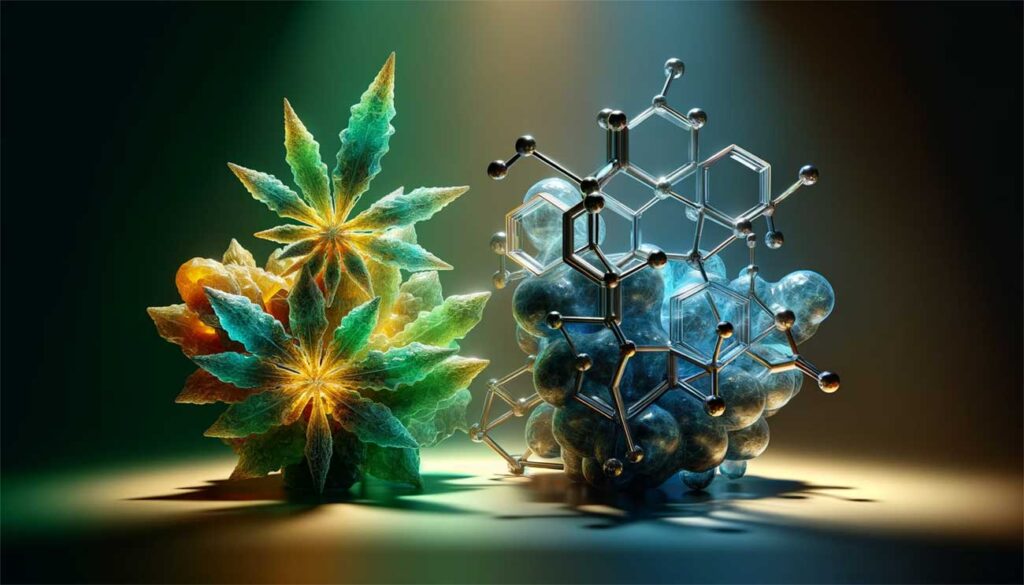While THC has long dominated discussions around cannabis, there’s a rising interest in cannabigerol (CBG), a lesser-known but increasingly significant cannabinoid. CBG, like THC, is derived from the cannabis plant, but it presents distinct properties and effects on the body, warranting a detailed exploration of their differences and potential benefits.
What Sets CBG Apart from THC
CBG: The Non-Psychoactive Alternative: Unlike THC, which is known for its psychoactive effects, CBG does not produce a “high.” This makes CBG a subject of interest for therapeutic applications without the psychoactive implications of THC. As a minor cannabinoid, it’s typically found in lower concentrations but has unique properties that contribute to its growing therapeutic interest.
Diverse Interactions with the Body: CBG and THC interact with different receptors in the body. THC primarily binds to CB1 receptors in the brain, producing psychoactive effects. CBG, however, shows a stronger affinity for CB2 receptors and interacts with serotonin receptors, impacting mood, appetite, and sleep. These interactions suggest varied therapeutic potentials for both cannabinoids.
Therapeutic Benefits: CBG and THC in Focus

- CBG’s Potential in Health and Wellness: CBG has been studied for its anti-inflammatory, analgesic, and neuroprotective properties. It shows promise in treating conditions like arthritis, chronic pain, neurodegenerative diseases, and even certain infections. These attributes position CBG as a potentially valuable component in natural health supplements.
- THC: A Double-Edged Sword: THC is lauded for its ability to manage chronic pain, nausea, and inflammation. It also assists in symptoms related to multiple sclerosis, PTSD, and epilepsy. However, its psychoactive effects can lead to cognitive impairments and anxiety in some users, highlighting the need for careful consideration in its therapeutic use.
CBG vs. THC for Anxiety and Medical Use
- Anxiety Management: CBG has shown potential in reducing anxiety without significant psychoactive effects, while THC’s psychoactive properties can offer temporary relief but may exacerbate symptoms in some cases. This distinction is crucial for individuals seeking anxiety relief.
- Medical Applications: Both cannabinoids show promise for medical uses but in different contexts. THC helps in pain management, appetite stimulation, and inflammation reduction. CBG is beneficial for conditions like glaucoma, anxiety, depression, and muscle spasms. Interestingly, a combination of CBG and THC may offer enhanced therapeutic benefits due to the entourage effect.
The Entourage Effect
The entourage effect suggests that the combination of various cannabinoids, including CBG and THC, can enhance their individual properties and therapeutic value. CBG, in particular, may mitigate the psychoactive effects of THC, offering a balanced approach in treatments.
CBG and THC in Clinical Studies
- Anti-Inflammatory Effects: A systematic review of in vivo studies highlighted that CBD, CBG, and combinations with THC consistently reduced pro-inflammatory cytokines. However, THC alone did not demonstrate these anti-inflammatory properties. This indicates a potentially broader anti-inflammatory scope for CBG and combinations with THC.
- Patient Perspectives on CBG: A survey of CBG-predominant cannabis users revealed high efficacy ratings for treating conditions like anxiety, chronic pain, depression, and insomnia. Most participants preferred CBG over conventional medicines for these conditions, citing a benign adverse event profile and negligible withdrawal symptoms.
Conclusion
In summary, THC and CBG, while both integral components of the cannabis plant, exhibit distinctly different properties and effects. THC, known for its psychoactive impact, offers significant therapeutic benefits but with potential drawbacks. CBG, in contrast, provides potential health benefits without the psychoactive effects, making it a preferable option for those seeking medicinal advantages without the high. Understanding their differences is key to making informed decisions about their use, tailored to individual health needs and goals.

